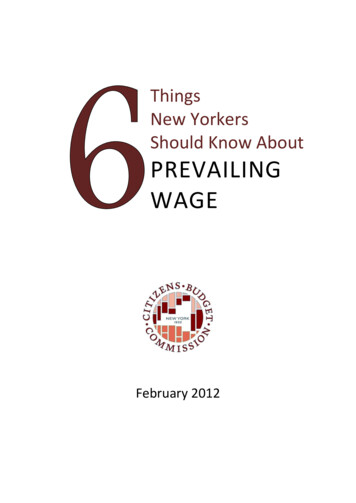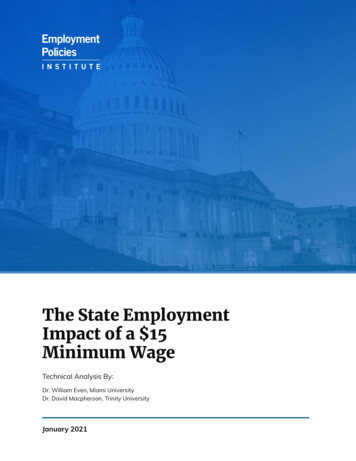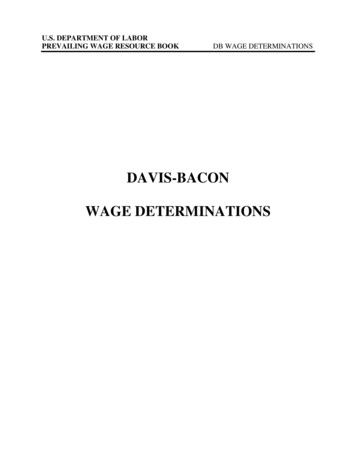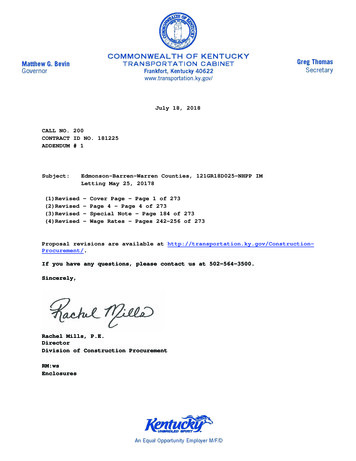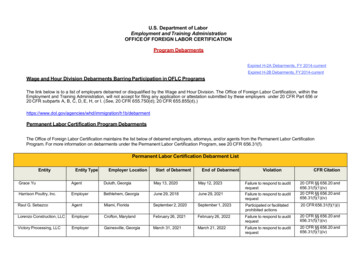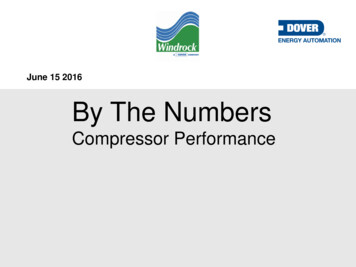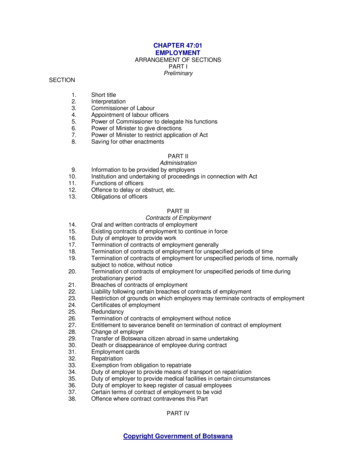
Transcription
NBER WORKING PAPER SERIESREVISITING THE MINIMUM WAGE-EMPLOYMENT DEBATE:THROWING OUT THE BABY WITH THE BATHWATER?David NeumarkJ.M. Ian SalasWilliam WascherWorking Paper 18681http://www.nber.org/papers/w18681NATIONAL BUREAU OF ECONOMIC RESEARCH1050 Massachusetts AvenueCambridge, MA 02138January 2013We are grateful to Marianne Bitler, Charles Brown, Lawrence Kahn, Jeffrey Thompson, Rob Valletta,seminar participants at UCSD, and anonymous referees for helpful comments, and to Arin Dube andhis co-authors for sharing their data and computer code. Neumark and Salas’ work on this projectreceived support from the Employment Policies Institute (EPI). The views expressed in this paperdo not necessarily reflect the views of EPI or of the Board of Governors of the Federal Reserve System,and the authors have retained full editorial control of the paper’s content and conclusions. All dataand programs used in this research will be available from the authors upon request when the researchis completed. This paper was prepared for presentation at the conference “Celebrating the Centennialof the U.S. Department of Labor,” November 9, 2012, Washington, DC. The views expressed hereinare those of the authors and do not necessarily reflect the views of the National Bureau of EconomicResearch.NBER working papers are circulated for discussion and comment purposes. They have not been peerreviewed or been subject to the review by the NBER Board of Directors that accompanies officialNBER publications. 2013 by David Neumark, J.M. Ian Salas, and William Wascher. All rights reserved. Short sectionsof text, not to exceed two paragraphs, may be quoted without explicit permission provided that fullcredit, including notice, is given to the source.
Revisiting the Minimum Wage-Employment Debate: Throwing Out the Baby with the Bathwater?David Neumark, J.M. Ian Salas, and William WascherNBER Working Paper No. 18681January 2013, Revised May 2013JEL No. J23,J38ABSTRACTWe revisit the minimum wage-employment debate, which is as old as the Department of Labor. Inparticular, we assess new studies claiming that the standard panel data approach used in much of the“new minimum wage research” is flawed because it fails to account for spatial heterogeneity. Thesenew studies use research designs intended to control for this heterogeneity and conclude that minimumwages in the United States have not reduced employment. We explore the ability of these researchdesigns to isolate reliable identifying information and test the untested assumptions in this new researchabout the construction of better control groups. Our evidence points to serious problems with theseresearch designs. Moreover, new evidence based on methods that let the data identify the appropriatecontrol groups leads to stronger evidence of disemployment effects, with teen employment elasticitiesnear -0.3. We conclude that the evidence still shows that minimum wages pose a tradeoff of higherwages for some against job losses for others, and that policymakers need to bear this tradeoff in mindwhen making decisions about increasing the minimum wage.David NeumarkDepartment of EconomicsUniversity of California at Irvine3151 Social Science PlazaIrvine, CA 92697and NBERdneumark@uci.eduJ.M. Ian SalasDepartment of EconomicsUniversity of California, Irvine3151 Social Science PlazaIrvine, CA 92697jmisalas@uci.eduWilliam WascherFederal Reserve BoardStop 66Washington, DC 20551william.l.wascher@frb.gov
I. IntroductionDebates about the economic effects and the merits of the minimum wage date back at least as faras the establishment of the Department of Labor as a cabinet-level agency in 1913. Given the absence ofempirical evidence on the effects of minimum wages in the early 1900s, the initial debates were largelybased on theoretical reasoning. The neoclassical school (including John Bates Clark, H. B. Lees-Smith,and Frank Taussig) argued that wage levels were determined by workers’ productivity and that minimumwages would reduce employment among low-skilled workers. In contrast, the progressives (such asSidney Webb, Rogers Seager, and John Commons) argued that minimum wages were necessary toprevent the widespread exploitation of lower-skilled workers by employers with greater bargaining powerover wages, would encourage workers to increase their efforts, and would boost consumers’ purchasingpower and thus raise aggregate demand.A similar debate erupted after the federal minimum wage was enacted in 1938. The mainprotagonists at that time were George Stigler (1946) and Fritz Machlup (1946), representing the“marginalist” school of economists, and Richard Lester (1946), who was considered an “institutionalist”economist. Again, the debate was primarily about the appropriate theoretical model of the labor market,although both sides also attempted to bolster their arguments with empirical analyses. Stigler andMachlup took the neoclassical position that minimum wages reduce employment, while Lester arguedthat product demand rather than wage rates was by far the most important factor determining employmentso that fairness was the more appropriate consideration in setting a wage floor.1Economists and statisticians from the Department of Labor have contributed importantly to theempirical literature on the economic effects of minimum wages over the past century. One of the firststatistical analyses of minimum wages in a U.S. state was conducted in 1915 by Marie Obenauer andBertha von der Nienburg of the Bureau of Labor Statistics (BLS), who examined the effects of aminimum wage for women that was introduced in Oregon between October 1913 and February 1914. For1Stigler acknowledged the possibility that minimum wages could raise employment in a labor market with amonopsonistic employer, an idea that would become more prominent in the 1990s. However, his own view was thatlow-wage markets were generally competitive in nature and thus that such monopsony effects were unlikely to beimportant in U.S. labor markets.1
this study, which was a precursor to the case study approach that constitutes a key branch of the empiricalliterature that blossomed after 1990, the BLS collected data on employment and wages by age and sex, aswell as sales, from 40 retail stores in Oregon for March and April of 1913, about five months prior to theintroduction of the minimum wage in the state, and for March and April of 1914, about five months afterthe minimum wage took effect. The study then compared the changes in the employment of women andmen over that period. Although quite cautious about the power of their difference-in-differencesstatistical approach (for example, the analysis was complicated by a recession in 1914 and by a legislatedreduction in working hours for women), the study concluded that the minimum wage had a positive effecton wages and little or no effect on women’s employment in the aggregate, but that stores substitutedteenage girls (who were subject to a lower minimum wage) for adult women in lesser-skilled jobs.Similarly, some of the first empirical analyses of the federal minimum wage law enacted in 1938were undertaken by analysts from the Wage and Hours and Public Contracts Division of the Departmentof Labor. In particular, the Department conducted a series of studies examining the effects of the newminimum wage on wages and employment in certain industries, either by comparing changes in wagesand employment in plants in low-wage southern states with their counterparts in higher-wage northeasternstates or by comparing employment changes in plants with different levels of average wages before thefederal minimum wage took effect. These studies, which tended to find modest disemployment effects,were followed by similar efforts by the Department to assess the effects of increases in the federalminimum wage in the 1940s and 1950s. The findings of these studies were at the center of a vigorousdebate between Richard Lester and John Peterson on the merits of the minimum wage in the late 1950sand early 1960s (Lester, 1960; Peterson, 1957, 1959, 1960).Over time, empirical analyses, especially the time-series studies conducted in the 1960s and1970s, increasingly found that minimum wages tended to reduce employment among teenagers, who wereviewed as a proxy for low-skilled labor more generally. A famous paper by Charles Brown, CurtisGilroy, and Andrew Kohen, published in 1982, surveyed the existing literature on minimum wages andestablished the “consensus” that a 10 percent increase in the minimum wage would reduce teenage2
employment by 1 to 3 percent (Brown et al., 1982). Following that study, economists began to coalescearound the idea that minimum wages have adverse effects on low-skilled employment.That consensus turned out to be relatively short-lived. After a decade of near-silence, the debateover the employment effects of the minimum wage reemerged in the early 1990s with the publication of aspecial issue of the Industrial and Labor Relations Review (ILRR). This issue featured four studies thatused different analytical approaches and that took advantage of the increasing divergence of minimumwages at the state level to estimate the employment effects of minimum wages. These studies, whichformed the basis for what is sometimes termed the “new minimum wage research,” were diverse in theirfindings, ranging from disemployment effects similar to the earlier consensus (Neumark and Wascher1992), to no effect on employment (Card 1992a) to a positive effect of the minimum wage onemployment (Card 1992b; Katz and Krueger 1992).The ILRR symposium launched a new body of contemporary research on the minimum wage,much of which was summarized in our 2008 book Minimum Wages (Neumark and Wascher, 2008). Inthat book, our evaluation and summary of the evidence concluded that “ [M]inimum wages reduceemployment opportunities for less-skilled workers, especially those who are most directly affected by theminimum wage” (Neumark and Wascher, 2008, p. 6). This paper, in part, extends this evaluation andsummary to the present by evaluating two recent studies that have questioned the empirical methods andconclusions in much of the recent literature (Allegretto et al., 2011; Dube et al., 2010).The key question raised by these recent studies is how researchers can best identify theemployment effects of the minimum wage – a question that is nearly as long-running as the debate overthe minimum wage. In particular, the identification of minimum wage effects requires both a sufficientlysharp focus on potentially affected workers and the construction of a valid counterfactual “control group”for what would have happened absent increases in the minimum wage. The latter is critical to account forother influences on the employment of potentially affected workers that may be confounded with theeffects of changes in the minimum wage. In the research of the past two decades, economists havefrequently used state variation in minimum wages to generate comparisons between states with different3
minimum wage levels or changes at the same point in time, to avoid confounding minimum wage effectswith other aggregate influences on the labor market (e.g., the national business cycle).Dube et al. (2010, hereafter DLR) and Allegretto et al. (2011, hereafter ADR) have put forward asevere critique of the state panel-data approach, including the work discussed at length in Neumark andWascher (2008). The essence of the argument in DLR and ADR is summarized in a review of MinimumWages by Dube (2011), which draws heavily on the findings from the two papers he co-authored:“ [V]ariation over the past two decades in minimum wages has been highly selective spatially,and employment trends for low-wage workers vary substantially across states This has tendedto produce a spurious negative relationship between the minimum wage and employment for lowwage workers – be it for sectors such as restaurant and retail or for demographic groups such asteenagers” (Dube, 2011, p. 763).Commenting on the econometric evidence more specifically, Dube writes: “Even simple regionalcontrols and trends produce employment effects close to zero, as do more sophisticated approaches suchas comparing contiguous counties across policy boundaries – which essentially embeds the “case study”approach within panel data analysis ” (pp. 763-4). Dube defines his and his co-authors’ studies as “afourth generation of recent work that tries to make sense of the sometimes contradictory evidence” (p.763), and argues that their work raises serious questions about the conclusions drawn by Neumark andWascher – and much of the broader literature – regarding the employment effects of minimum wages.Echoing Dube, ADR assert without reservation that their results overturn the conclusion thatminimum wages reduce employment of low-skilled workers: “Interpretations of the quality and nature ofthe evidence in the existing minimum wage literature must be revised substantially. Put simply, ourfindings indicate that minimum wage increases – in the range that have been implemented in the UnitedStates – do not reduce employment among teens” (ADR, 2011, p. 238). Similarly, DLR conclude thatthere are “no detectable employment losses from the kind of minimum wage increases we have seen inthe United States” (DLR, 2010, p. 962).Our principal goal in this paper is to evaluate this new research because of the strong challenge itposes to the large body of prior research that found that minimum wages reduce employment of lowskilled workers. As the description of the work above suggests, the central element of this new researchis the issue of how to construct counterfactuals for the places where minimum wages are increased. The4
authors of both studies argue that one must compare places that are geographically proximate to havevalid controls, because, according to them, minimum wage changes are correlated with unobservedeconomic shocks to areas that can confound the estimation of minimum wage effects. Consequently,much of the analysis in this paper focuses on the validity of this criticism, and on the approaches thesestudies take to address this potential problem. The overriding concern we have with these studies is thattheir research designs, out of concerns about avoiding minimum wage variation that is potentiallyconfounded with other sources of employment change, discard a great deal of valid identifyinginformation – throwing out the identifying “baby” along with, or worse yet instead of, the contaminated“bathwater.” Our findings, in a nutshell, indicate that neither the conclusions of these studies nor themethods they use are supported by the data.II. Recent Research Challenging the Conclusion that Minimum Wages Reduce the Employment of LowSkilled WorkersOf the two papers by Dube and his colleagues, the analysis in ADR is the most direct extension ofthe state panel-data approach used extensively in the existing research on the employment effects ofminimum wages. In this study, ADR focus on standard specifications of minimum wage effects on theemployment of teenagers, using information on state-level minimum wages and individual-level datafrom the Current Population Survey (CPS) from 1990-2009. When they estimate a model that includesstate and period fixed effects along with other standard controls, they find a negative employment effectof minimum wages. However, when they include either state-specific linear trends or Census division period interactions (or both), the estimated employment effects of minimum wages fall to approximatelyzero and are statistically insignificant.In contrast, DLR’s analysis focuses primarily on restaurant employment using county-levelQuarterly Census of Employment and Wages (QCEW) data from 1990-2006. Although they presentsome results from panel data models that include state-specific trends and Census division periodinteractions (along with county fixed effects), their core analysis uses a research design based on crossborder county pairs. Their specification includes county pair period interactions intended to control forshocks common to both counties, and thus identifies the effect of minimum wages from differences in5
employment changes in paired counties on either side of a state border. This narrowing of identificationto within-county-pair comparisons causes the employment effects to go from negative and sometimesstatistically significant to small and insignificant.Closely related findings are reported in Addison et al. (2012). They also use QCEW data,focusing on nearly the same period (1990-2005) and on nearly the same sector. With regard to DLR’sfirst set of analyses, about the only difference is that the authors include county-specific linear trends.However, the qualitative conclusion is the same: they find negative employment effects when theyinclude only county and quarter fixed effects, but no evidence of employment effects when they includecounty-specific trends. Similarly, in a 2009 paper these same co-authors estimate these models forvarious parts of the retail sector with county-specific time trends, and also do the same border-countyanalysis as in DLR, with similar findings.2To put this new evidence in context, it is useful first to assess the implications of these results forthe existing state-level panel studies, especially since ADR and DLR have explicitly used their findings tocast doubt on the evidence from these studies. With regard to DLR’s paper, it is worth noting that verylittle of the existing work is on the restaurant sector or the retail sector more broadly, so new evidence onrestaurant or retail employment does not address the far more pervasive evidence on teens or other verylow-skilled workers. For one thing, the evidence from the earlier research is strongest for individualsmost directly affected by the minimum wage, and many workers within the restaurant or retail sector earn2Addison et al. (2011) use similar methods to try to estimate the effects of minimum wages in the United Statesduring the Great Recession, and conclude that there is not evidence of disemployment effects. However, perhapsbecause of the short time period studied and the large movements in aggregate labor market outcomes during thatperiod, the standard errors on the point estimates are so large as to be uninformative. For example, in some cases(e.g., teens) the authors find negative employment effects that are in the earlier “consensus” range but that are notstatistically significant. We have similar concerns about the results reported in Hirsch et al. (2011), who study theeffects of the recent federal minimum wage increases on employment at “quick-service” restaurants in Georgia andAlabama. They report estimated employment elasticities, with respect to the wage cost increases induced by thehigher minimum wage, that are sometimes positive and sometimes negative, but that also have large standard errors(about 0.4-0.5). They also estimate the effects of the cumulative increase – which are not reported in the paper butwere supplied in a personal communication from Barry Hirsch – and find negative and sometimes large effects(ranging from 0.12 to 0.92) that are statistically insignificant (with standard errors of 1.2), suggesting that themain problem may be uninformative data.6
well more than the minimum wage. For another, the minimum wage can lead employers to substitutehigher-skilled workers for lower-skilled workers without reducing net employment very much.3ADR’s research focuses primarily on teenagers and can therefore be viewed as posing more of adirect challenge to the findings from the state-level panel data approach. Even in this case, however, thepotential for labor-labor substitution among teenagers with different skill levels means that the effects ofminimum wages on overall teenage employment can be difficult to detect; for example, larger grossdisemployment effects among the least-skilled teens may be masked by inflows of other teens intoemployment.4 Indeed, the most recent estimates Neumark and Wascher have presented for teenagersshow negative effects only for male teens when disaggregating by sex, and only for black or Hispanicmale teens when disaggregating male teens into whites vs. black or Hispanic (Neumark and Wascher,2011). And other work, focused on the lowest-wage workers rather than on teenagers per se, findsnegative employment effects for them as well (Neumark et al., 2004). Nonetheless, a negative effect ofminimum wages on employment of the lowest skilled ought to imply negative effects for at least somegroups of teenagers, and for the sample period they study, ADR do find that a panel data model with onlystate and year fixed effects produces evidence of disemployment effects in the range of past estimates.Thus, their finding that this conclusion is sensitive to whether state-specific linear trends or region period interactions are included in the specification poses a challenge to the conventional view of3DLR acknowledge this possibility, noting that “ [O]ur data do not permit us to test whether restaurants respondto minimum wage increases by hiring more skilled workers and fewer less skilled ones” (p. 962). However, theexisting literature suggests that such labor-labor substitution is important. For example, Fairris and Bujanda (2008)find evidence of labor-labor substitution by city contractors in response to the Los Angeles living wage ordinance –a different kind of mandated wage floor. In addition, in a study of personnel records from over 600 establishmentsof a single large retail firm, Giuliano (forthcoming) finds that large minimum wage-induced increases in the wagerates of teenagers relative to adults were associated with increases in employment for teenagers from highersocioeconomic status zip codes and decreases in the employment of young adults (ages 20-22). Moreover, data onthe individual workers who were laid off and on store performance indicated that at some stores the teens that werehired were of higher quality than teens already employed at the stores, and of higher quality than the young adults atthe stores. Similar evidence consistent with this substitution from low-skilled adults to possibly higher-skilledteenage students (in food-service occupations) is reported in Lang and Kahn (1998). Finally, Neumark and Wascher(1996) find evidence of this substitution among teens, with a higher minimum wage drawing those enrolled inschool and working part-time into full-time work, while pushing those working full-time and not enrolled in schoolout of jobs into “idleness” (neither working nor employed).4The focus on teenagers is, to some extent, a vestige of the old time-series literature. Because labor economists hadto aggregate employment data by age group, it made sense to look mainly at teenagers because minimum wageworkers comprised such a small share of older age groups.7
minimum wage employment effects. We next turn to a more thorough explanation of their analysis, aswell as an evaluation of it; we then do the same for the DLR study.III. Evaluation of the EvidenceAllegretto et al. (2011)As noted above, ADR find that the negative effects estimated from standard state-level panel dataspecifications of the effects of minimum wages on the employment of teenagers are sensitive to includingeither state-specific linear trends or Census division period interactions (or both). This leads them toconclude that models with only state and year fixed effects “fail to account for heterogeneousemployment patterns that are correlated with selectivity among states with minimum wages. As a result,the estimates are often biased and not robust to the sources of the identifying information” (p. 205). Morespecifically, they argue that “Lack of controls for spatial heterogeneity in employment trends generatesbiases toward negative employment elasticities in national minimum wage studies” (p. 206).We re-examine these findings with the same CPS data, using a specification with the sameaggregate variables they include. The sample is extended to take account of newer data (which does notchange the basic conclusions), and, whereas ADR use individual-level data with clustering at the statelevel, we aggregate the data to the state level by quarter, also clustering at the state level.5 The minimumwage, here and throughout, is defined as the higher of the state and federal minimum.As can be seen in Table 1, the results closely mirror what ADR found (their Table 3). In themodel that includes the standard labor market controls along with state and time fixed effects,6 theestimated employment elasticity with respect to the minimum wage is 0.165, significant at the 1% level(ADR estimate an elasticity of 0.12, significant at the 5% level).7 When either state-specific lineartrends are added, region quarter interactions are added, or both are added simultaneously, the estimated5Aggregated data are used because this form is more convenient for some of the analyses that follow, particularlythose that focus on the time-series patterns in the data by state. Moreover, because the identifying information is thestate-level minimum wage variation, the use of state-level data for the other variables should be inconsequential.6Because ADR use micro-data rather than state-level data, they also include controls for individual demographiccharacteristics.7The specification is in logs so the estimated coefficient is the elasticity; in contrast, ADR estimate linearprobability models for employment with the log of the minimum wage on the right-hand side. They report themagnitude and statistical significance of the estimated linear probability coefficients, and then the implied elasticity.8
elasticities become considerably smaller (ranging from 0.098 to 0.009) and are statistically insignificant.The same is true in the ADR results (their Table 3), where the estimates are statistically insignificant andthe estimated elasticities range from 0.036 to 0.047.8This evidence suggests that conclusions about the effects of minimum wages on teenagers maynot always be robust to the type of identifying variation used to estimate these effects: differences inwithin-state variation associated with minimum wage changes relative to other states in the same year;differences in within-state variation relative to other states in the same year that is also net of statespecific linear trends; or (essentially) differences in within-state variation relative to states in the sameCensus division.Interestingly, the only time ADR question the validity of their approach is with regard to theirevidence of statistically significant negative effects on hours of Hispanic teens. In response to thesefindings, they write “the puzzling and somewhat fragile evidence for Hispanic teens may be driven by theconcentration of Hispanic teens in a small number of Census divisions, on the one hand, and the smallnumber of Hispanic teens in most states at the beginning of the sample period. These patterns reduce theability to estimate effects for this group robustly within our methodology” (2011, p. 234). Similarly, theyargue that “[I]ncluding spatial controls renders the estimates for Latinos particularly imprecise andfragile” (p. 208). But in their Table 7, on which this discussion is based, the estimates are actually moreprecise for Hispanics than for blacks, yet they conclude that “controlling for spatial heterogeneity byusing within-Census division variation is particularly important when looking at African-Americanemployment effects” (p. 234).Rather than judgmentally deciding where and when to include area-specific time trends or region period dummies based on unclear criteria like these, researchers should examine what sources ofvariation provide better estimates of the effects of minimum wages. In the context of this paper, this8We also experimented with a specification that added controls for the adult wage and adult employment-topopulation ratio, and defining these variables (and the adult unemployment rate) for skilled adults aged 25-64 withmore than a high school education. The estimated minimum wage effects were very similar to those reported inTable 1.9
preferred approach entails exploring the implications of including state-specific trends or region timeinteractions and whether doing so results in more or less reliable estimates of minimum wage effects.State-Specific Trends. We first focus on the evidence regarding state-specific trends, which areintended to control for longer-run influences not captured in the other control variables. It has becomestandard practice to assess the robustness of panel data estimates of state policy effects to the inclusion ofstate-specific trends, including in the minimum wage literature (e.g., Neumark and Wascher, 2004 and2011). If these kinds of analyses deliver robust results that are insensitive to the inclusion of these trends,then they can clearly bolster the evidence. If, however, they point to different evidence, then theresearcher has to seriously explore which analysis is most convincing, rather than simply relying on apriori hunches.The first thing to note is that Neumark and Wascher (2011), using data from 1994-2007, foundthat the estimated effects of minimum wages on teen employment are negative and significant inspecifications that include state-specific trends.9 This result raises the question as to whether there issomething different about the sample period ADR studied that makes it problematic to include linearstate-specific trends. An obvious candidate is the severe recession at the end of their sample period, as isthe recession at the beginning of their sample period (in 1990 and 1991). In models that include statespecific trends, the recessions at the beginning and end of ADR’s sample period could have a largeinfluence on the estimated state-specific trends –
much of which was summarized in our 2008 book Minimum Wages (Neumark and Wascher, 2008). In that book, our evaluation and summary of the evidence concluded that " [M]inimum wages reduce employment opportunities for less-skilled workers, especially those who are most directly affected by the minimum wage" (Neumark and Wascher, 2008, p. 6).
